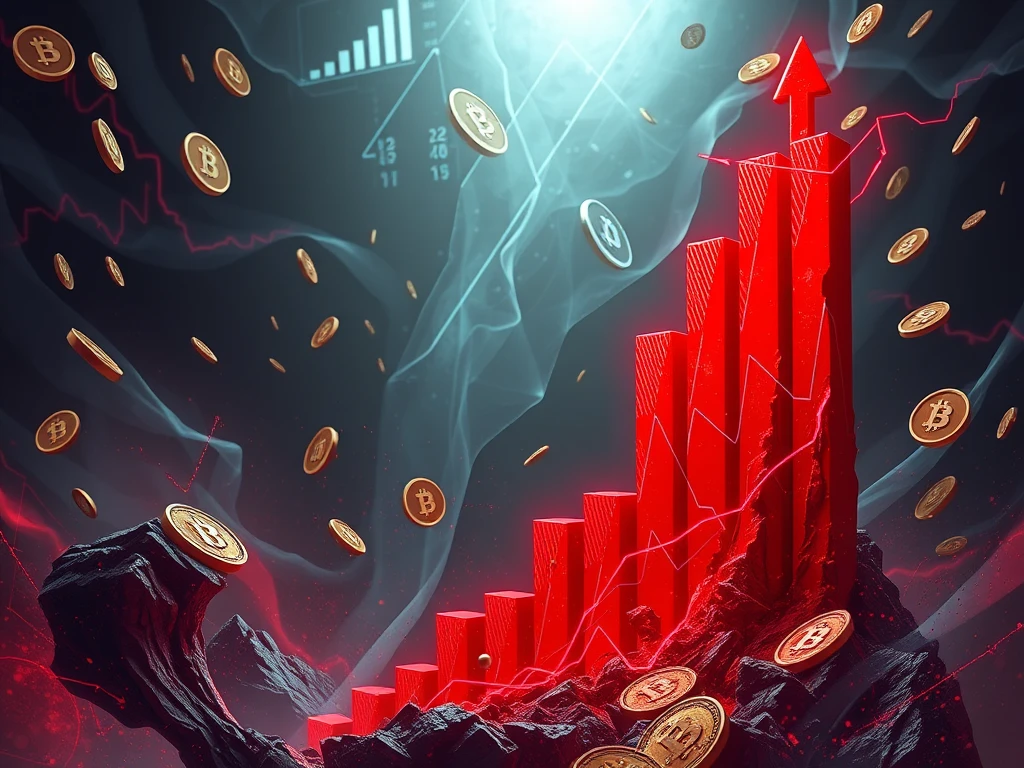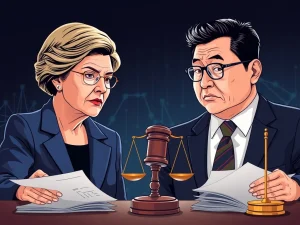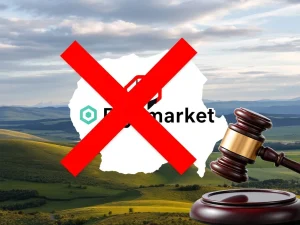Sudden Crash: Unraveling the Mystery Behind Mantra’s OM Token 90% Collapse

The cryptocurrency market witnessed another day of high drama as Mantra’s OM token experienced a devastating collapse, plummeting over 90% in just 24 hours. This sudden crash, reminiscent of the Terra (LUNA) implosion, sent shockwaves through the crypto community, leaving investors reeling and searching for answers. Let’s delve into the timeline of events, dissect the rumors, and analyze the market forces that led to this dramatic altcoin price drop.
The Shocking OM Token Crash: A Timeline of Chaos
On April 13th, Mantra’s OM token, which had been riding high on the real-world asset tokenization narrative, experienced a catastrophic price drop. From trading comfortably above $6, the OM token’s value evaporated, sinking below $0.50. This rapid descent wiped out billions in market capitalization and triggered widespread panic. Here’s a detailed breakdown of the 24 hours that defined the Mantra OM token collapse:
April 13 (16:00–18:00 UTC): Initial Signs of Instability
- The OM token was trading sideways, showing no immediate red flags.
- A minor dip occurred, with the price decreasing from $6.14 to $5.52. This seemed like typical market fluctuation at the time.
April 13 (18:00–20:00 UTC): The Crypto Liquidation Cascade Begins
- The unthinkable happened: the OM token price entered freefall.
- Within the first hour, it plunged to $1.38.
- The descent continued relentlessly, hitting a low of $0.52 in the subsequent hour.
- In a mere 24 hours, the OM token lost over 90% of its value, sparking immediate speculation about a potential rug pull or other malicious activity.
- Social media platforms exploded with theories ranging from insider dumping to exchange manipulation, as traders desperately sought explanations for the unprecedented crypto liquidation event.
April 13 (20:00–22:00 UTC): Rug Pull Rumors and Mantra’s Initial Response
- Early speculation centered on a ‘rug pull’ scenario, fueled by a screenshot of a deleted Telegram channel.
- However, this rug pull theory was quickly debunked as the deleted channel was not Mantra’s official communication platform.
- Mantra issued its first statement on X (formerly Twitter), but the brief message received immediate criticism and backlash from the concerned community who demanded more clarity on the OM token crash.
April 13 (22:00–00:00 UTC): CEO Mullin Blames Centralized Exchanges
- Mantra co-founder and CEO, John Patrick Mullin, provided a more detailed statement on X.
- Mullin attributed the market volatility to “reckless forced closures initiated by centralized exchanges on OM account holders.”
- He argued that the crash’s timing and severity suggested sudden, poorly communicated account position closures, potentially during low-liquidity hours, indicating negligence or intentional market manipulation by exchanges during this crypto liquidation event.
April 14 (00:00–02:00 UTC): Wallet Analysis and Laser Digital Speculation
- Blockchain analysis revealed that in the days leading up to the crash, significant OM token deposits (43.6 million OM worth $227 million) were made into Binance and OKX from at least 17 wallets.
- Blockchain data platform Arkham Intelligence labeled two of these wallets as belonging to Laser Digital, a strategic investor in Mantra.
- This labeling ignited speculation and accusations against Laser Digital, though the accuracy of Arkham’s labels remained unconfirmed.
- Mullin, in his X replies, hinted that internal investigations pointed to a single exchange as the primary cause, explicitly excluding Binance.
April 14 (02:00–05:00 UTC): Exchange Responses and Tokenomics Scrutiny
- Both Binance and OKX responded to the unfolding situation surrounding the OM token crash.
- Binance acknowledged the “significant price volatility” and stated their initial findings pointed to “cross-exchange liquidations.”
- OKX CEO Star Xu called the event a “big scandal” and promised full transparency, stating OKX would prepare reports for investigation.
- OKX further revealed their investigation had uncovered “major changes to the MANTRA token’s tokenomics model since Oct 2024” and “potentially coordinated large-scale deposits and withdrawals across various centralized exchanges since Mar 2025,” raising further questions about the underlying factors contributing to the altcoin price drop.
April 14 (05:00–12:00 UTC): Laser Digital Denies Wallet Ownership and Dormant Wallet Activity
- Laser Digital vehemently denied ownership of the wallets labeled by Arkham and reported by Lookonchain, calling them “mislabeled” and refuting any OM token sales.
- Lookonchain identified another wallet, labeled by Arkham as belonging to Shane Shin of Shorooq Partners, which had been dormant for a year before becoming active hours before the crash, receiving 2 million OM shortly before the crypto liquidation.
April 14 (12:00–13:00 UTC): Mullin Addresses Community Concerns
- Mullin appeared on Crypto News Insights’s Chain Reaction show to address the community directly.
- He denied allegations of investor dumping and refuted claims that the team controlled 90% of the OM token supply, referencing a recent transparency report.
- Mullin emphasized that OM token recovery was the team’s top priority and announced early plans for a potential token buyback program to mitigate the impact of the crypto market analysis pointing to a severe altcoin price drop.
April 14 (13:00–16:00 UTC): Market Maker Theories and Further Denials
- New theories emerged, with Onchain Bureau initially claiming market makers at FalconX were responsible due to loan option contract expirations.
- This theory was quickly retracted by Onchain Bureau, and denied by both FalconX and Mullin, who clarified FalconX was a trading partner, not a market maker.
- Crypto detective ZachXBT added another layer to the mystery, alleging individuals linked to Reef Finance sought substantial OM-backed loans just before the crash, adding more intrigue to the OM token crash saga.
Decoding the OM Token Crash: What We Know So Far
The Mantra OM token collapse has spawned numerous theories, from rug pulls to insider trading, all of which Mantra has vehemently denied. While the exact cause remains under investigation, several key points have emerged from this crypto market analysis:
- Mantra’s Denial: Mantra has consistently denied any project-led malicious activity, providing wallet addresses and engaging with the community and media to reassure investors.
- FalconX Not to Blame: The theory implicating FalconX as the market maker responsible for an expiring deal has been debunked.
- Laser Digital’s Denial and Arkham Labels: Laser Digital has denied ownership of wallets labeled by Arkham Intelligence, attributing the tags to AI mislabeling with low confidence. Arkham has yet to respond to requests for clarification on these labels.
Path to Recovery: Mantra’s Next Steps
In the aftermath of this dramatic altcoin price drop, Mullin pledged to burn his and his team’s OM tokens, starting with his own allocation. Mantra has committed to publishing a post-mortem analysis and released an initial “statement of events,” reiterating that no project token sales occurred and team tokens remain locked. The team is focusing on a token buyback and burn program, and has engaged a blockchain analyst to investigate the root cause of the Mantra OM token collapse. The crypto community awaits further details as Mantra navigates this crisis and strives to rebuild trust and confidence in the OM token project following this tumultuous crypto liquidation event.
The Mantra OM token collapse serves as a stark reminder of the volatile nature of the cryptocurrency market and the critical importance of liquidity, transparency, and robust exchange practices. As investigations continue, the industry watches closely, hoping for clarity and lessons learned from this shocking episode.








